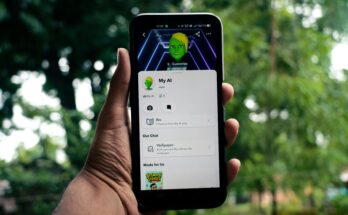Introduction
Over the past two decades, cellphones have changed quickly. From svelte, touchscreen-based products to large machines with traditional keyboards, the sector has always embraced invention. Still, a fresh change is about to come. Consumers starting to question **Is the future of smartphones foldable or wearable** as technology develops. Both systems have special advantages that shape users’ interaction with their devices. While wearable technology combines smart elements into daily accessories, foldable phones offer bigger screens without compromising pocket space. Manufacturers pushing the boundaries of design and usefulness must also consider which technology will predominate in mobile devices going forward. The benefits, drawbacks, and possibilities of foldable and wearable cellphones are investigated in this paper in order to identify which innovation has more promise.
The Rise of Foldable Smartphones
The mobile sector has seen a major transformation thanks in great part to foldable handsets. Foldable devices from major companies such Samsung, Huawei, and Motorola provide consumers a blend of portability and big display experiences. These smartphones’ flexible OLED technology lets the screen bend without breaking. Foldable phones appeal mostly because they can turn from a little gadget into a tablet-sized screen, therefore improving productivity and multimedia consumption.
Foldable phones provide several difficulties even with their inventiveness. Manufacturing still costs a lot, which drives luxury prices that restrict availability. Durability issues also remain since folding systems could fade over time. Still, constant developments in engineering and materials could help to solve these problems. Prices might reduce as more businesses fund foldable technologies, therefore increasing its broad appeal. But will wearable technology take front stage or will foldables replace conventional cellphones?
The Growth of Wearable Technology
Wearable technology now encompasses smartwatches and fitness trackers as only two examples. Flexible displays and small-sized components have opened the path for **wearable smartphones**—devices combined into glasses, clothes, even biometric accessories. Wearables alter interaction and provide hands-free, immersive experiences unlike foldable cellphones, which keep a conventional form factor.
Among the most awaited wearable technologies are **smart glasses**. Aiming to find a fresh approach to interact with digital content, companies including Apple, Google, and Meta are significantly funding augmented reality (AR) glasses. By overlaying data straight onto the user’s field of vision, these gadgets lessen the need to view another screen. Wearables present major challenges, too, including privacy issues, limited battery life, and the difficulty of designing them comfortable and fashionable for daily usage.
Usability and Consumer Preferences
Comparatively between foldable and wearable smartphones, usability is quite important. Foldable phones provide a familiar experience that keeps typical smartphone functions while adding adaptability. Users that give screen size and multitasking first importance could find foldables more enticing. Conversely, wearables offer **convenience and flawless integration** into daily life. A smartphone tucked within a bracelet or eyewear replaces the necessity for carrying another gadget.
Mostly, consumer preferences will determine whatever technology survives. Although early adopters are excited about both developments, the typical user favors simplicity, cost, and usefulness. While wearables must overcome doubt and design constraints, foldables need on advances in durability and affordability to be successful. Market trends will show which solution more fits daily needs as companies hone these technologies.
The Role of 5G and AI in Future Devices
Advancements in **5G connection and artificial intelligence (AI)** will help both foldable and wearable smartphones. Faster internet speeds will improve cloud-based apps, hence lowering the demand for heavy hardware. AI-driven assistants will enhance user interface, so simplifying gesture and voice instructions. These technologies will affect wearables as well as foldables, therefore influencing user interaction with their gadgets.
AI can maximize multitasking and intelligently change app layouts depending on use patterns for foldable cellphones. Conversely, wearables will depend on artificial intelligence for real-time data processing, hence allowing tailored experiences. AI and 5G together could close the distance between these technologies and perhaps result in hybrid gadgets that provide the best of both worlds.
Which Technology Will Dominate?
Several elements influence whether or if the future of smartphones is foldable or wearable: technology developments, customer acceptance, and industry investment among others. Already firmly ingrained in the market, foldable cellphones attract consumers who want more screens without sacrificing mobility. Though still in its infancy, wearables offer a transforming change in human interaction with technology.
Wearables reflect a more futuristic vision while foldable smartphones hone current designs. Wearable technologies may finally replace conventional cellphones if businesses can overcome obstacles including privacy issues and battery life. Foldables, however, offer a **more immediate and practical evolution** of mobile technology, so they are probably going to lead in the near future.
Conclusion
Both foldable and wearable technology are influencing the direction of smartphones. Although foldables improve the current smartphone experience, wearables provide a whole fresh approach of interacting with digital content. Every technology has advantages and drawbacks; the best winner will rely on user acceptance, technological innovations, and price range.
Consumers might not have to make decisions between wearable and foldable electronics in the next years. The next major breakthrough might be a hybrid method combining wearable elements with flexible screens. One thing is clear regardless of the path the sector goes: the future of smartphones is changing and the next generation of mobile devices will be more advanced, user-friendly, and immersive than past ones.
Frequently Asked Questions(FAQ)
1. Describe foldable smartphones and their working mechanisms.
Flexible OLED display technology helps foldable smartphones bend without breaking. These devices provide more flexibility for consumers since they can change between a small phone size and a bigger screen.
2. Wearable cellphones are what?
Wearable cellphones combine mobile technology with items like clothes, wristbands, or eyewear. Usually using augmented reality (AR), or voice control, they provide hands-free communication and immersive digital experiences.
3. Are foldable phones durable?
Foldable phones still suffer with screen creasing and hinge wear even if their durability has improved. Manufacturers are creating stronger materials to increase lifetime.
4. Will wearable devices replace conventional cellphones?
Though they could eventually replace conventional models, wearable cellphones have to overcome problems including battery life, design restrictions, and privacy issues before general acceptance.
5. For regular use, which technology is more sensible?
For most consumers, foldable cellphones are more sensible since they provide a familiar experience with extra screen area. Though wearables offer convenience, more work is needed to match the adaptability of conventional cellphones.



